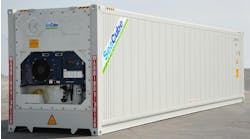Visitors to Mid-America Trucking Show view some potential future trailer technologies—along with new designs that are available right now
ADVANCEMENTS in trailer technology—some baby steps, others leaps of faith—were evident at this year’s Mid-America Trucking Show held March 27-29 in Louisville, Kentucky.
The 2014 edition of MATS featured exhibits by 1,077 companies and attracted more than 79,000 people from 43 states and 10 nations.
With heavy truck fuel economy standards now gaining the attention of regulators, weight savings and aerodynamics are more important than ever. These, along with corrosion resistance, operational flexibility were some of the key benefits that trailer manufacturers were emphasizing this year.
Several of these benefits were wrapped up in a futuristic trailer that Great Dane developed—a 53-foot van trailer made of full-length composite panels. The concept trailer was part of a commitment by Walmart to cut its fuel consumption in half over the course of 10 years, starting in 2005. The retailer is well on its way to achieving that goal. In eight years, the company has cut fuel consumption by 84%, primarily through operational changes. Walmart now is looking to tractor and trailer manufacturers to help the company achieve the remaining 16% reduction.
The trailer may be a concept vehicle, but it is roadworthy. When the show was over, it left on a promotional tour that will take it across the country.
While the aerodynamic tractor and trailer promise to squeeze more miles out of a gallon of diesel, Walmart recognizes that achieving that goal will be the result of a wide range of changes, including repackaging goods to get more of them on the trailer, figuring ways to reduce overall fleet mileage, and taking a close look at every component on the tractor and trailer.
“We know there is no silver bullet,” Elizabeth Fretheim, director of business strategy and sustainability – logistics for Walmart said at a MATS press briefing. “But we are 84% of the way to our goal. We are looking for changes in tractors and trailers to get us the rest of the way.”
Among the novel features of the trailer is the use of carbon fiber for the skins of the panels that comprise the sidewalls.
“Carbon fiber can be wound on spools and woven like any other thread,” said Adam Hill, Great Dane’s vice-president of product and sales engineering. It’s expensive—$10 per pound vs less than a dollar a pound for steel. But it’s interesting how much the price of carbon fiber has dropped. It used to be $100 per pound.”
The walls use composite panels produced by Milliken and Fiber-Tech Industries. One key reason for using carbon fiber: The panels are only one-third the weight of conventional FRP panels. The roof, sides, and floors of the 53-foot trailer each consist of one-piece panels. Side panels are a made of carbon fiber skins and a composite core produced by Milliken. Carbon fiber also is used on the floor of the trailer—a single composite panel with balsa as the core.
While a substantial amount of engineering time went into the design, production of the trailer displayed at MATS went surprisingly quickly.
“We built it at our Terre Haute plant on a Saturday morning,” Hill said. “The panels are bonded with adhesives, and we used fasteners to hold everything in place until the adhesive cured.”
Advanced aerodynamic devices smooth airflow—including a custom faring mounted ahead of the landing gear. The faring connects the side skirts, resulting in a unified front to slash turbulence beneath the trailer.
Off-the shelf components used on the trailer include an SAF Holland PosiLift suspension that automatically lifts one axle when enough of the cargo has been unloaded, making the axle unnecessary.
Peterbilt produced the futuristic tractor that was coupled to the trailer. The custom cab has exceptionally little frontal area, with the only seat—mounted in the center—belonging to the driver. The look is more fighter jet than conventional truck cab.
A Capstone Turbine engine and an electrical powertrain team up to provide the power. Capstone Turbines specializes in microturbine power.
“The small turbine acts as a range extender,” said Capstone’s Steve Gillette. “The advantages include the ability for the truck to run on a variety of fuels with the same efficiency. And no SCR is required.”
New Eagle developed the software that helps the components to communicate with one another. Much of the communication is done wirelessly. ♦



